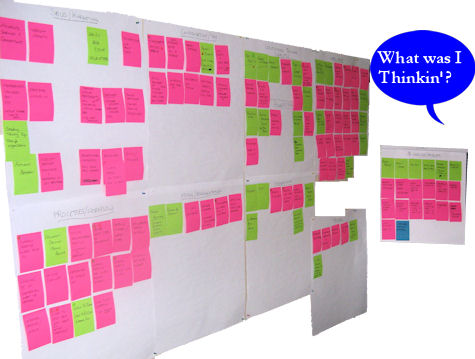Holding this type of information in your head will cause it to explode – and cause your business to implode.
By the way – fatigue comes from trying to hold too many pieces of information in the head – studies show that your brain uses more than 50% of your caloric intake when really focused and thinking. Studies also show that we only effectively handle up to three ideas at any one time. And then to cap it all off, we know that writing things down is a very effective way to help remember them.
The power of writing down the things you think of and especially the things that worry you the most can be seen in the photo. What is even more powerful is where these thoughts and ideas can lead and where they can branch off to.
The image shows some of the things that were keeping my client awake at night and causing all types of stress and health issues during the day. This and too many Red Bull’s had him constantly on edge.

What would you do with all of that information?
As we worked on this project the client began to have some realizations:
- Wow! Look at all the stuff I gotta do!
- I don’t have enough hours in the day to do all of this!
- Time exists so that you don’t have to do it all at once.
- His job as the manager is to determine what is critical and who is to deal with it.
And the biggest reason he wants to get going on his plan?
He lost a contract worth $50,000 because he was paying attention to the rest of his business, too busy fighting fires.
Be sure to subscribe to the RSS feeds so you get the next article in this series.
[sig]

I agree writing stuff down is a critical element of business (or personal) management – and risk management. Your thoughts get clarified, the planning or “to do” steps get better organized, and you – and others – can follow the roadmap you’ve created. Finally it’s an archive and you can refer back to it when you need to accomplish the same or a similar task in the future.